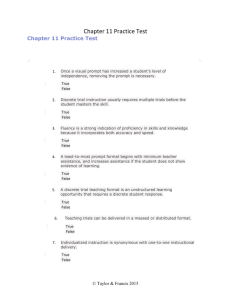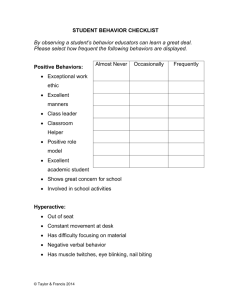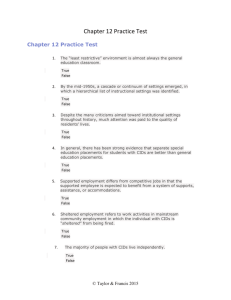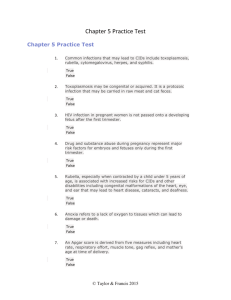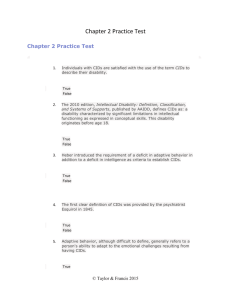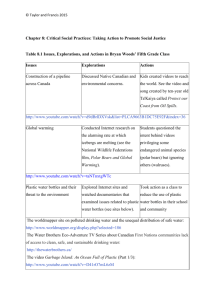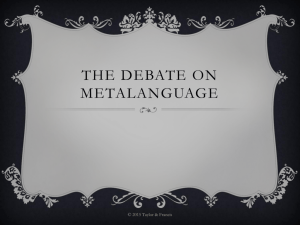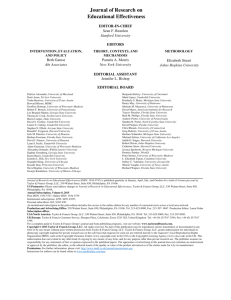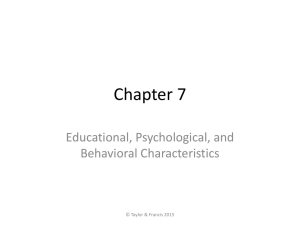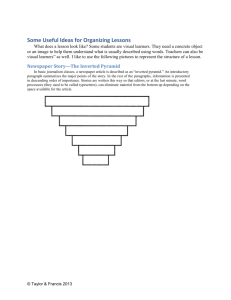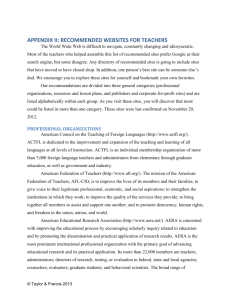Cognitive and Learning Characteristics
advertisement
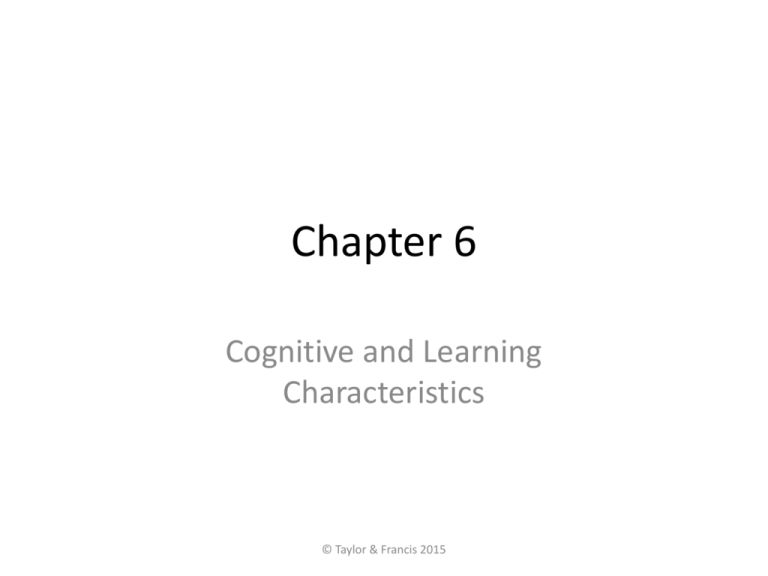
Chapter 6 Cognitive and Learning Characteristics © Taylor & Francis 2015 COGNITIVE CHARACTERISTICS • Intellectual functioning must be viewed within the context of (a) adaptive behavior, (b) participation, interactions, and social roles, (c) health, and (d) context (environment and culture). • Constructivist theories of development emphasize that an individual constructs, through increasingly complex cognitive functions, his/her understanding of the environment, events, interactions with others, as well as his/her own thoughts and actions. • Piaget identified four major stages of development including the sensorimotor, preoperational, concrete operational, and formal operational stages. © Taylor & Francis 2015 COGNITIVE CHARACTERISTICS • The zone of proximal development is from Vygotsky’s theory of development and is the range of tasks that are too difficult for a person to master alone but can be learned with guidance and assistance. • Scaffolding is the process of altering the level of guidance or assistance given as a child becomes increasingly effective and efficient at various skills and mental functions. • Developmental delay occurs when a person learns much of the same knowledge/skills in the same developmental sequence as those without disabilities, but at a slower rate. • Developmental difference occurs when a person displays behaviors that are atypical of children or adolescents. • Both cognitive delays and differences are evident in the population of people with CIDs. © Taylor & Francis 2015 LEARNING CHARACTERISTICS • Transfer and generalization of knowledge and skill refers to the ability to use knowledge and skills in the same or different ways in a new setting or situation. • Transfer and generalization is a common area of difficulty often resulting in a greater need for support and guidance in various environments. • Learning strategies are the methods we use to help us acquire, retain, retrieve, and eventually use knowledge. • Some research suggests that people with CIDs can and do use learning strategies although their strategies may be less sophisticated, fewer in number, and may not be transferred/generalized as well as those used by people without disabilities. • Attributions are to what we attribute our successes and failure and are related to strategy use. © Taylor & Francis 2015 METACOGNITION • Metacognition has to do with an individual’s ability to understand about his/her own knowing or to learn about his/her own learning. • In general, individuals with milder levels of CIDs are able to learn strategies and use their metacognition, although the more abstract the material to be learned and the performance tasks become, the greater the challenge in their learning and use. © Taylor & Francis 2015 ATTENTION CHARACTERISTICS • Visual orienting. This is an early indicator of how well children can focus their visual attention. • Relevant versus irrelevant stimuli. Many individuals with CIDs experience difficulty in attending to stimuli that are relevant to learning and ignoring or filtering out those stimuli that are not relevant (often referred to as distractibility). • Maintaining attention. Some people with CIDs have difficulty maintaining attention over sustained periods of time (often referred to as a short attention span). © Taylor & Francis 2015 MEMORY CHARACTERISTICS • Working and short-term memory are processing resources that can be of limited capacity that involve preserving information while simultaneously processing the same or other information. Short-term memory involves the ability to store small amounts of information for a short period of time. Working memory involves the ability to take information in the short-term memory and relate it to other information. Working memory and short-term memory are closely related. • Problems in storage and retrieval of information may result from lack of attention to what is relevant, short attention span, lack of learning strategies, and both short-term and long-term memory deficits. Retrieval difficulties emerge when an individual has trouble remembering or applying stored information when needed. • Individuals with more severe levels of CIDs may have multiple disabilities and experience these problems in cognition, learning, attention, and memory to even greater degrees than those with milder levels. © Taylor & Francis 2015 SPEECH AND LANGUAGE CHARACTERISTICS • The ability to use language is very important in developing cognition, learning, attention, and memory. • Language is a form of communication, whether spoken, written, or signed, that is based on a system of symbols and that can be used to produce an infinite number of messages from a finite set of symbols and rules. • For people with milder levels of CIDs, delays in speech and language may be more evident than differences. • Speech disorders are more commonly found among people with CIDs than in the general population. • Language use and intelligence are linked in the perception of many people. People with limited language abilities may be perceived to be less intelligent. © Taylor & Francis 2015 SPEECH AND LANGUAGE CHARACTERISTICS • For individuals with more severe levels of CIDs, differences in speech and language development are more evident than for those with milder levels. • Augmentative and alternative communication systems may be useful in assisting individuals with speech and language deficits. • Echolalia, or repeating what is said to one, is an example of a difference. © Taylor & Francis 2015
